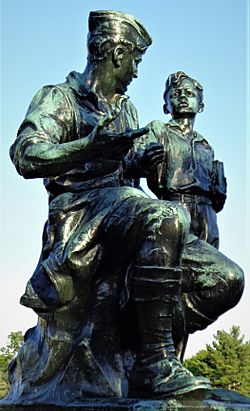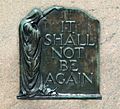Massachusetts Peace Statue facts for kids
Quick facts for kids Massachusetts Peace Statue |
|
|---|---|
|
Orange Peace Statue It Shall Not Be Again!
|
|
| Artist | Joseph Pollia |
| Year | 1934 |
| Type | Bronze |
| Dimensions | 3.7 m (12 ft) |
| Location | Memorial Park, Orange, Massachusetts |
The Massachusetts Peace Statue is also known as It Shall Not Be Again. It is a special statue in Orange, Massachusetts. It honors soldiers who fought in World War I.
In 2000, the government of Massachusetts officially named it the state's peace statue. This means it is the official symbol of peace for the entire state.
A sculptor named Joseph Pollia (1894-1954) created the statue. It was first shown to the public on May 30, 1934. When it was first shown, it became famous across the country. Even First Lady Eleanor Roosevelt sent a letter about the event.
The statue shows a soldier, called a doughboy, who has just returned from the war in France. He looks tired and is sitting on a tree stump. Next to him is a young American schoolboy, about 10 years old. The soldier has his arm around the boy. The boy seems to be listening carefully to the soldier. He has his fist clenched, as if he is thinking hard.
You might have seen this statue on TV! It appeared in the fifth episode of Castle Rock. This show is on Hulu and is based on stories by Stephen King.
What the Statue Means
This statue has a very important message: "It Shall Not Be Again." This phrase means we should never have another terrible war like World War I. People say this is the only peace statue of its kind.
The statue stands on a two-part base. This base has a special plaque on it. The plaque shows a woman's face from the side. Next to her are the words "It shall not be again."
The woman on the plaque has her left hand over a shield. Her right hand is near her face. At her feet, you can see a soldier's helmet and a gun. There are eleven stars on the shield. These stars represent the eleven young men from Orange who died in World War I.
The words "It Shall Not Be Again" come from a poem. The poem is called "Apparitions" by Thomas Curtis Clark (1877-1953). He was a poet who wrote many Christian hymns.
Here is part of the poem: Who goes there, in the night,
Across the storm-swept plain?
We are the ghosts of a valiant war —
A million murdered men!
Who goes there, at the dawn,
Across the sun-swept plain?
We are the hosts of those who swear:
It shall not be again!
Images for kids







